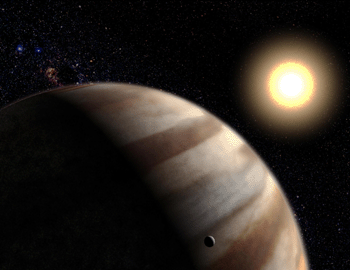A chemical has been detected in the atmosphere of an extrasolar planet for the first time. David Charbonneau and Timothy Brown of the National Center for Atmospheric Research in Colorado observed sodium in the atmosphere of the Jupiter-like planet that orbits a Sun-like star known as HD 209458. This is the first direct evidence for an atmosphere on a planet beyond our solar system and is likely to spark many similar searches. Astronomers have detected 76 extrasolar planets to date.

Using the Hubble space telescope, Charbonneau and Brown inspected the planet as it passed in front of its parent star, which is 150 light years away. Light from the star passed through the planet’s atmosphere, and the researchers detected the well-known absorption lines of sodium in the yellow region of the spectrum. The 3.5-day orbital period of the planet gave the pair frequent chances to make observations.
The researchers then had to make sure that the absorption lines arose from the atmosphere of the planet rather than the star. To do this, they exploited the fact that absorption lines arising from the star’s atmosphere have their wavelengths slightly Doppler-shifted due to the relative motion of the star and the planet. Extremely sensitive measurements of the motion of the planet established that the sodium lines did indeed arise from the planet’s atmosphere. It is unclear whether this chemical signature is typical of such planets, or if it is unique.
Charbonneau and Brown narrowed their search to sodium after computer models predicted that it would be present in the planet’s atmosphere. Previous studies of the planet had shown that it is a gas giant like Jupiter, which also contains sodium gas. The chemicals associated with life were excluded from the search because such planets are very unlikely to harbour life.
“Only a decade ago, planets outside our solar system were still in the realm of science fiction”, says Charbonneau. “Suddenly, discussing searches for Earth-like planets seems quite reasonable”.
Charbonneau and Brown are now studying starlight reflected to Earth from the planet. They are using highly sensitive detectors because only 0.01% of the light from the parent star reaches them. But the duo are optimistic that these studies will lead to the first measurements of the colour and reflectivity of an extrasolar planet.



